All 2 entries tagged Contorniate
No other Warwick Blogs use the tag Contorniate on entries | View entries tagged Contorniate at Technorati | There are no images tagged Contorniate on this blog
October 16, 2018
Converting Roman coins into tesserae: development and value
The conversion of Roman coins into coin-like objects is a practice documented during the imperial period. Although it is not always easy to date and determine the value of countermarks, incisions and other types of intervention on coins after their production, full academic awareness has not yet been acquired on the complexity of the reuse of coins in antiquity, which lost their previous economic function in order to acquire new meanings and purposes. In addition to pierced specimens – which were hung on the neck by a cord (funiculum) to be reused as amulets or jewels – official Roman coins were also transformed into tesserae by erasing their reverses and engraving Roman numerals on the surface instead.
 |
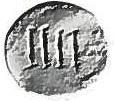 |
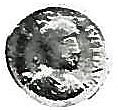 |
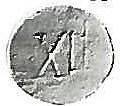 |
Figures 1-2: Late Antique coins with numerals scratched on the reverse. Both are bronze coins, BnF Paris.
The specimens shown above (Figs. 1-2), both held in the Bibliothèque nationale de France (BnF), bear on their obverses respectively the draped, cuirassed, and diademed bust of Julian the Apostate (on the left) and Theodosius I (DN THEODO-SIVS PF AVG) right (on the right). The reverses of both specimens were erased and smoothed, with the Roman numerals IIII and XII incised respectively. This phenomenon also appears to be attested on some earlier fourth-century bronze coins, e.g. those carrying the portrait of Maxentius and Constantius II (Alföldi 1975, Taf. 7, nos. 9-10) on the obverses. However, their conversion into tesserae may have occurred before, at the same time or even after that of the two pieces mentioned above.
 |
|
Figure 3: Bronze coin (Münzkabinett, Staatlichen Museen Berlin).
A specimen kept at the Münzkabinett in Berlin (Fig. 3) bears the bust of Julian the Apostate left on the obverse, while the image originally depicted on the reverse was erased and replaced with two engraved symbols, namely a palm branch and the monogram PE (“palma emerita”, “praemia emerita”?) whose meaning is controversial. Both motifs frequently occur on contorniates as well as on late Roman material culture, and they could allude to games and competitions or may have been used just as propitious and favourable symbols. Nevertheless, it is unclear how these motifs on contorniates were interpreted by their recipients, and even less clear how they connected with the function of the contorniates.
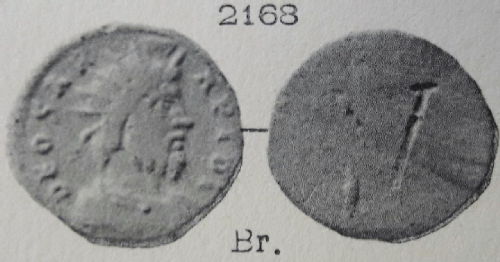 |
Figure 4: Vota Publica brass token (“Festival of Isis coinage”) (Collection H. Hoffmann, Médailles grecques et romaines, françaises et etrangers. Auktionskatalog Delestre-Rollin-Feuardent, 2-11 Mai 1898, Lot 2168).
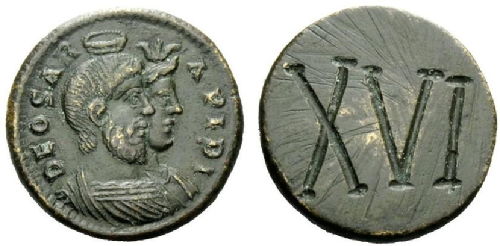 |
Fig. 5 Fig. 5: Vota Publica brass token (“Festival of Isis coinage”): Numismatica Ars Classica NAC AG, 23.05.2016, Auction 92, Lot 781. 2.75 g
Roman numerals could be engraved not only coins but even on tokens themselves, again converting them from one purpose to another. The two pieces shown above (Figs. 4-5) belong to the so-called “Vota Publica issues” (or “Festival of Isis coinage”) and, in particular, they have to be ascribed to the so-called “Anonymous series”, generically dated to the fourth century. A specimen carrys the radiate and draped bust of Serapis right, while the number V is incised on the reverse. Another piece, repeatedly published in auction catalogues since 1950, bears the crowned and draped busts of Isis and Serapis right, while the number XVI is engraved on the smoothed surface of the reverse. The obverse types of these two brass tokens show the same iconographies depicted on some Vota Publica specimens published by Alföldi (see Alföldi 1937, Taf. 7,31; Taf. 14).
Undoubtedly, the Roman numerals incised on the reverse of these coins and tokens evoke the Roman tesserae with numerals belonging to the Julio-Claudian period (27 BC – AD 68), which show the busts of members of the imperial dynasty or other depictions on the obverses, and Roman numbers generally within a laurel wreath – sometimes with the additional letters A or AVG – on the reverses. Also the so-called spintriae, characterized by erotic images (symplegma) on the obverses, carry Roman numerals on the reverses, at times connected by scholars to a ludic function (game counters) or an erotic context (“brothel tokens”). In addition to these two categories of tesserae, bone and ivory tokens also bear numbers written in both Latin and Greek on one side, and they were regarded as gaming counters on the basis of their findspots.
How should we interpret the coins as well as the Vota Publica specimens that were converted into tokens by engraving Roman numerals on their reverses? This kind of transformation of late Roman coins into tesserae suggests that they probably imitated earlier tokens carrying Roman numerals, and this presupposes a demand for this type of object also in the following centuries. The interpretation of these special “tesserae” is therefore closely related to the unknown function of earlier Roman tokens with Roman numerals, suggesting a continuity between the tokens of the earlier and later Roman period in terms of imagery and reception. New evidence could help to clarify the meaning of Roman numerals as well as the purpose and effects of these objects within Roman society across a longer term perspective.
This blog was written by Cristian Mondello, a British Academy Visiting Fellow at Warwick. This research is supported by the British Academy’s Visiting Fellowships Programme under the UK Government's Rutherford Fund.
Select Bibliography
Alföldi A., A Festival of Isis in Rome under the Christian Emperors of the IVth Century (Budapest 1937).
Alföldi A., ‘Heiden und Christen am Spieltisch’, JAC 18, 1975, pp. 19-21.
Bianchi C., ‘«Pedine alessandrine»: testimoni illustri di un gioco ignoto’, in Lambrugo C. & Slavazzi F. (eds.), I materiali della Collezione Archeologica “Giulio Sambon” di Milano (Milano, 2015), pp. 53-65.
Buttrey Th., ‘Spintriae as a Historical Source’, NC 13, 1973, pp. 52-62.
Campana A., ‘Le Spintriae: tessere romane con raffigurazioni erotiche’, in Morello A. (ed.), La donna romana. Immagini e vita quotidiana. Atti del convegno, Atina, 7 marzo 2009 (Cassino, 2009), pp. 43-96.
Küter A., ‘Roman tesserae with numerals – Some thoughts on iconography and purpose, in Rowan C., Crisà N. & Gkikaki M. (eds), Tokens: Culture, Connections, Communities, ed. by (London: Royal Numismatic Society, forthcoming).
Mittag P.F., Alte Köpfe in neuen Händen: Urheber und Funktion der Kontorniaten (Bonn 1999).
Perassi C., ‘Monete amuleto e monete talismano. Fonti scritte, indizi, realia per l’età romana’, Numismatica e Antichità Classiche. Quaderni Ticinesi 40 (2011), pp. 223-74.
August 17, 2017
Gaius Mitreius, Magister Iuventutis, and the Materiality of Roman Tokens
Amongst the ancient tokens kept in the coin cabinet of the Ashmolean Museum in Oxford is this piece struck from brass (orichalchum). One one side is a male bust (perhaps of Mitreius or more generally a representation of "youth") surrounded by the legend C. MITREIVS L. F. MAG. IVVENT - Gaius Mitreius, son of Lucius, master of the youth (the iuventutes was a youth organisation). On the other side is a two-story building with columns that looks very much like a basilica. On the building is inscribed L. SEXTILI∙ S.P. = Lucius Sextilius, at his own expense.
 |
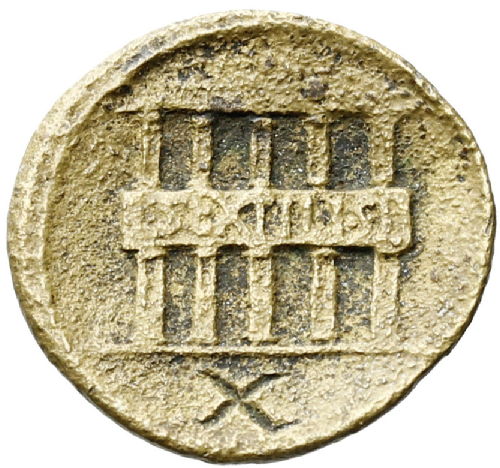 |
Token from the Ashmolean Museum (Oxford). (20mm, 3.58g, die axis 6).
In his analysis of Roman tokens Rostovtzeff discusses this type (p. 60), noting that the example in Paris has a countermark underneath the bust. This piece has the number X (10) etched into the exergue on the reverse, but other specimens carry the numbers VIIII and IIII. The structure on the reverse also varies on different examples (as is typical of numismatic representations of buildings) - other representations show a more circular structure that has been identified as an amphitheatre. The representation of the same or similar scenes with differing numbers is reminiscent of the famous spintriae, bronze tokens that carry sex scenes on one side and differing numbers on the other. The fact that the numbers appear to be incised into the token after it was struck is also similar to a practice known in late antiquity, where contorniates (late antique tokens whose purpose remains debated) where inscribed with Christian symbols, palm branches or other designs after striking. One example of this practice is shown below on a piece from the British Museum: a palm branch has been etched into a contorniate that shows Homer on one side and Bacchus on the other.
 |
We don't know anything further about the Lucius Sextilius named on the token, nor about Mitreius beyond the fact that he held an office connected with the iuventutes, the youth organisations that existed in the western part of the Roman Empire (also known as collegia iuvenes). But we do possess inscriptional evidence for the Mitreius name at Rome and in Gubbio (CIL VI, 28976 and 38641, CIL XI, 5861, AE 1988, 347). A Mitreius token like that shown above was reportedly found on the island of Capri, although this specimen is now lost (Federico and Miranda 1998, 363).
This was not the only token struck by Mitreius in connection with his position as magister iuventutis. He also struck a type with the same obverse (a male bust and his name) with a facing lion's head within a wreath on the reverse. Other bronze types carried the same obverse with a number within a wreath on the reverse (IIII, XI and XII are known - Cohen VIII 12-15, and Triton IV, 449, the specimen pictured below) - this again is very similar to the design of spintriae. Another specimen, now in a private collection, carries Mitreius' name and a tripod on one side and two clasped hands with a poppy seed on the other - this token also appears to be countermarked in the image.
Mitreius was not the only official connected to Roman youth organisations to strike tokens; several types exist in lead that refer to youth groups or to festivals connected to these same groups. One example is shown below: on one side is a youthful male portrait with the legend PPETRI SABI (Publius Petronius Sabinus) and on the other side is the legend MAG VIIII IVV (Magister Iuvenum VIIII - Master of the Youth, Nine) (TURS 834).
 |
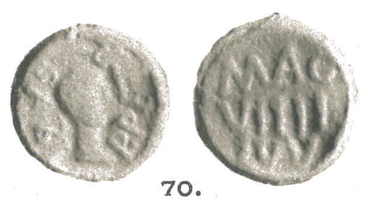 |
| Mitreius bronze token. | Sabinus lead token. |
That officials associated with youth organisations struck tokens in orichalcum, bronze and lead suggests that different materials might be used for tokens that were ultimately used in the same context. In this sense we should study all Roman tokens together as one class of material, rather than, as has previously been the case, separating the bronze from the lead, or the "spintriae" from other types. Clay tokens are also known from Rome, and may also ultimately provide further illumination on what, and in what contexts, these objects were used for. But these types are further evidence that some tokens were used within Roman colleges or other organisations, and may ultimately have been connected to feasts, games, celebrations or festivals.
This blog was written by Clare Rowan as part of the Token Communities Project. Thanks are due to Denise Wilding for undertaking the photography and recording of this and other tokens from the Ashmolean collection.
Bibliography:
Federico, E. and E. Miranda, eds. (1998). Capri Antica. Dalla preistoria alla fine dell'età romana. Capri, Edizioni La Conchiglia.
TURS - Rostowzew, M. (1903). Tesserarum urbis romae et suburbi. St. Petersburg.
Rostowzew, M. (1905). Römische Bleitesserae. Ein Beitrag zur Sozial- und Wirtschaftsgeschichte der römischen Kaiserzeit. Leipzig, Dieterich'sche Verlagsbuchhandlung.

 Clare Rowan
Clare Rowan

 Please wait - comments are loading
Please wait - comments are loading

 Loading…
Loading…

